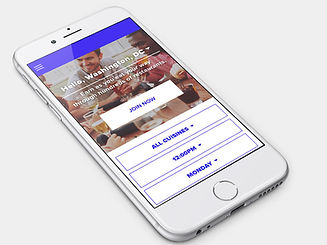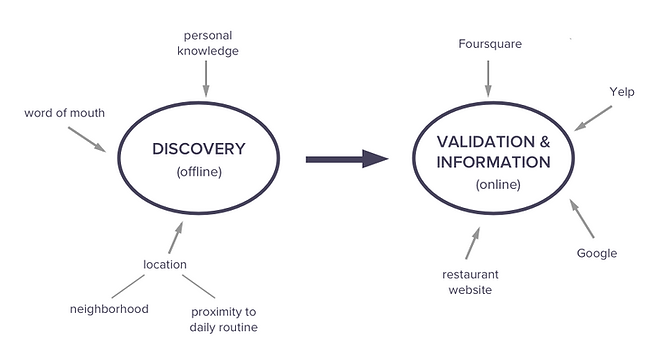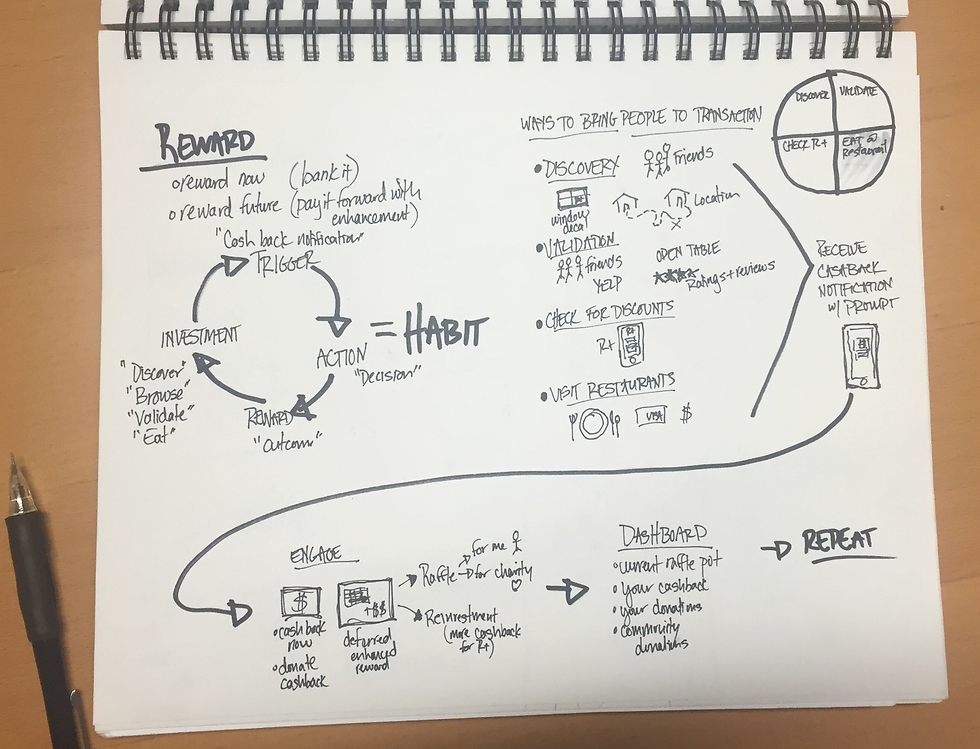Senior Product Designer
Restaurants Plus by LivingSocial
A Simpler, Smarter Dining Loyalty Experience

Project Overview
Product Strategy
Native App
Context
Restaurants Plus, a loyalty and rewards program by LivingSocial, offers customers cashback for dining at participating restaurants. Restaurants benefit by attracting new customers and driving traffic during slow periods.
B to C
Challenge
The existing mobile website in test markets (Atlanta & San Diego) was passively informational, lacking features to engage or incentivize customers. The goal was to define and design an engagement strategy for a native app version.
Solution
A Restaurants Plus native app that prioritizes real-time, location-based restaurant discovery while emphasizing the post-transaction cashback experience.
My Role
As Lead UX Designer & Researcher, I led research, strategy, wireframing, prototyping, and UX, collaborating with Business Intelligence, Marketing, Engineering, Product, and Visual Design to shape the app experience.
HOW IT WORKS
Meet Sarah...

Sarah is a 29 year old Assistant Marketing Director who lives in the Bay Area. She loves eating out with friends but it can get pricey and doesn't want to put the time into finding ways to save money. She also gets frustrated with knowing where to eat because online reviews aren't always reliable.
"It can be hard to tell how good a restaurant is. I’ll check Yelp reviews but usually I go to a place that someone recommends."
Native App Browse
HOW WE GOT THERE
Research & Discovery
How People Discover and Decide Where to Eat
Before brainstorming app ideas, we first needed to understand our customers and their key challenges. We did this by:
-
Analyzing data from the Restaurants Plus test launch in two cities
-
Reviewing past surveys and research from our card-linking technology partner
-
Conducting new surveys and interviews on eating habits and loyalty programs

How users discover & validate restaurants.
Research Findings
Restaurant Selection Behavior
-
People select restaurants based on recommendations or personal knowledge, then check Yelp or Foursquare for menus, ratings, and reviews.
-
Most dine at familiar spots near home or work, except on weekends when they’re more willing to travel for a destination experience—especially if recommended by family or friends.
-
The top search filters are “distance from me” and “neighborhood.”
-
Behavior differences:
-
Restaurants Plus users seek nearby dining options for immediate plans.
-
LivingSocial users plan meals in advance.
-
Loyalty Programs Pain Points
-
Requiring a physical card to participate
-
Overly complicated programs
-
Perceived as benefiting the company more than the customer
"I saw it [the restaurant] on my way home from work. Then I looked at the Yelp rating."
"I always forget my [loyalty] card."
"What do 'points' really mean?"
"I had a doctor's appointment in the neighborhood. My sister had told me about a good lunch place close to there so I decided to check it out."
Research & Discovery
Personas
To humanize and refine our research insights, we created personas to guide the design process. The current Restaurants Plus customer differed in age and income from LivingSocial’s target audience. We prioritized a secondary persona that aligned with LivingSocial’s goals.

Research & Discovery
Competitive Analysis
We wanted to understand two aspects of our competition. First, discover how others approached the food and loyalty spheres in order to figure out the opportunity for Restaurants Plus. Second, learn about the tools and strategies used to sell these apps to customers.

Competition in the food and loyalty program space
Research & Discovery
Making Connections
From the research and interview findings, we were able to articulate the problems & pain points that were opportunities that could be solved by the Restaurants Plus native app. Starting with those needs, we brainstormed ways to approach and solve the problems that we had identified.
Insights
-
We’re not going to win on merchant volume & density
-
We’re not going to win on browse alone
-
We’re not going to win on social alone
Problems to Solve
-
Immediacy
-
Neighborhood-driven location
-
A social component for friends & recommendations
-
Validation - ratings & reviews
AND......What is the hook?
Discovery
Finding Our Strategy
We played around with a variety of approaches but they all lacked the ‘hook’ that we were looking for. Finally, as we sketched out the steps involved in finding and transacting at a Restaurants Plus restaurant, we realized the emotional impact of receiving the ‘free money’ from your transaction cashback. This was the ‘hook’.



Restaurants Plus Engagement Cycle

VISUALIZING AND TESTING
Sketching
Now that we had discovered the emotional ‘hook’ of the post-transaction cashback, we held design studios and starting to sketch, test and iterate on ways to visually solve the the pain points, research findings and post-transaction cashback ‘hook’.
Post-Transaction 'Hook' Concept

Post-transaction is the primary native app use case.
We designed a post-transaction hook that appeals to different aspects of human nature. After each transaction, users can choose to:
-
Donate to a local cause
-
Bet in a raffle
-
Get cash back on their credit card
Users must have the app installed to manage their cashback.
Browse Concept

With post-transaction cashback as the core of the Restaurants Plus app, pre-transaction browsing becomes a function of cashback.
This approach:
-
Emphasizes urgency, making cashback a key decision factor
-
Aligns with research, ensuring the experience is immediate and neighborhood-focused
First Browse Iteration

Testing
To determine the best way to browse restaurants, we tested multiple map and list view combinations.
Results:
-
The hybrid map and list view performed best.
-
The full list view and full map view followed.
-
The map view with a single restaurant tile performed worst and was removed.
Hybrid View

List View
Map With Single Tile


Revising & Refining




Roadblock
When designing the map and list view, we researched leading apps, focusing on Google and Apple Maps. User testing favored Apple Maps' structure, so we handed those designs to engineers.
The Android team flagged several interactions as technically unfeasible. To address this, we collaborated with Android and iOS developers, brainstorming and prototyping solutions that balanced user testing insights with technical constraints.

Final Designs
The final compromise removed the hybrid map and list view, the main technical challenge for Android. Instead, we implemented a single restaurant tile map view, aligning more closely with Google’s design. This solution maintained both map functionality and quick access to restaurant details.



Learnings
Start Small and Learn
Testing a basic version in two markets gave valuable user insights, helping shape the next phase of Restaurants Plus.
Check In Often
Regular conversations with engineers and stakeholders would have prevented wasted effort and kept everyone on the same page.